
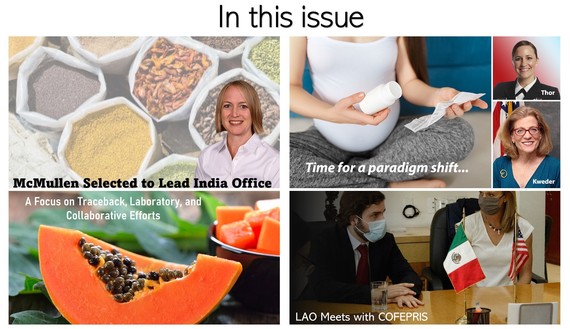

McMullen Selected as Director of India Office
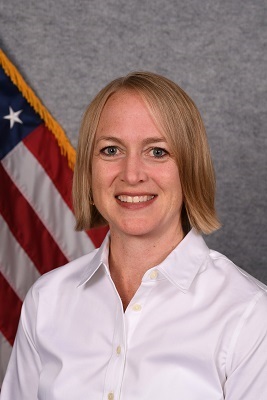 |
|
Sarah McMullen, Ph.D. has been selected as director of the OGPS India Office (INO), a position she has performed on detail since April when the previous director retired. Prior to her promotion, McMullen served as the deputy director of INO.
“With this promotion as the new director, Sarah continues to apply a wealth of valued leadership and technical experience to the India Office,” Office of Global Operations Director Bruce Ross said in a message to staff.
|
McMullen is a chemist by training, having received her Doctor of Philosophy in inorganic chemistry and Bachelor of Science in chemistry from Emory University. She started her career in the laboratory and has worked as a chemist, tissue residue specialist, consumer safety officer (CSO), and manager.
“I've been really fortunate to be able to go around to different places within the agency. It's really helped my understanding of the commodities we regulate, the different divisions that are stakeholders to us now and the work of the field. It's been a great, almost 20-year journey now with FDA,” she said.
Her first opportunity to work outside of the lab occurred when she was hired by John Verbeten, as a CSO within the Division of Import Operations (DIO). She tells the story of how he challenged her to be better than previous analysts who transitioned to DIO. Along with this challenge came mentorship and vision that inspired her to consider leadership roles within DIO and subsequently OGPS.
Currently midway into her second tour in INO, McMullen’s workdays start early and end late. Most recently, she and a few of her staff worked round the clock helping to facilitate the procurement and delivery of USG aid delivered to India during the second wave of the pandemic.
McMullen’s work is grounded in forming partnerships with regulatory counterparts, industry, and multilateral organizations. She also manages what she describes as “a tight-knit” staff, and one of her initiatives as director is to continue to build the team and recruit for critical vacancies.
People often reach out to discuss what it is like to serve on an overseas tour, and McMullen is always pleased to share her experiences. She said the one of the best parts of working in INO is “the opportunity to make a difference.”
Scientist to Diplomat: A Road Less Traveled
The Hashemite Kingdom of Jordan sits at the crossroads of Asia, Africa and Europe, and its capital is Amman, a large modern city with numerous ancient ruins. Health Scientist Layla Batarseh, born and raised in Amman, has also sat at many crossroads, moving from toxicologist to FDA policy analyst, from university to government, from northern and southern U.S. states and back to Amman.
|
And, as is true for many of us, defining life experiences helped launch her journey. Family summers spent in a rural village nurtured her love of science and environment, where “I learned how to fetch water from the spring; knead dough and bake it on a fire; make sun-dried raisins and figs; and milk sheep,” Batarseh said. “We would sleep on floor mattresses in the open and count the stars. Looking at those jet-black skies with the brilliant stars still takes my breath away.”
Batarseh enrolled at the American University of Beirut in Lebanon at 17, where she was hailed as the “Golden Hand of Jordan” for her ability to repeatedly score three-point shots during college basketball games. While at the university, she earned an undergraduate degree in biology and a master’s degree in biology-physiology.
|
|
 |
After teaching courses in biology, anatomy, and physiology for four years at the University of Jordan, Batarseh received a scholarship from the Royal Hashemite Court[1] to study environmental health sciences, which she used to study water quality at the University of Michigan’s School of Public Health and ultimately obtain a Ph.D. in toxicology. That’s where she learned that “all substances are poisons and only the right dose differentiates a poison from a remedy.”
[1] Established at the time of the creation of the Jordanian State, the RHC is the official body that oversees the preparation and implementation of His Majesty’s local and international activities. Moreover, the RHC provides the necessary political, administrative, and diplomatic support to the executive, legislative and judicial branches of the state to enable them to fulfill the tasks entrusted to them by the Constitution.
Batarseh in traditional Middle Eastern dress
Although she returned to Jordan for a while to conduct research, eventually Batarseh’s transcontinental travels landed her permanently in the United States, at the FDA’s National Center for Toxicological Research in rural Jefferson, Arkansas, to work on reproductive toxicology. But the prospect of city life soon prompted her to take a job in Washington, D.C., at the FDA's Center for Food Safety and Applied Nutrition (CFSAN). No longer in the lab, Batarseh rigorously applied her scientific way of thinking and approaching issues to ensuring the safety of additives in food.
 |
|
After 16 years, Batarseh found a new challenge, one matched to her unique background: first as director of the FDA’s Middle East and North Africa Regional Office (MENA), and then as a senior regional advisor in Amman. As advisor, Batarseh built relationships with MENA counterparts, learned how food and medical products were regulated in those countries, and, to help strengthen regulatory systems in the region, educated and trained both regulators and industry. |
Batarseh’s ability to communicate fluently in Arabic with FDA’s regulatory counterparts added an intangible level of trust and helped advance FDA’s mission, she said.
 Traditional Middle Eastern street food
When the MENA office closed in December 2013, Batarseh shifted and began work related to the activities of the Pan American Health Organization Executive Board, the United Nations General Assembly, the Joint United Nations Programme on HIV/AIDS Programme Coordinating Board, and the UN Environment Programme. Specifically, Batarseh’s duties have included coordinating FDA reviews of position papers prepared by the U.S. Departments of Health and Human Services and of State, preparing briefing materials and talking points, and managing several cooperative agreements.
For this line of work, Batarseh said having solid policy, diplomacy, and presentation skills, along with a deep understanding of FDA regulations and requirements, is a plus, and having a science background is a bonus. "I believe my science background is a strong foundation for what I do.”
 |
|
Outside of work, Batarseh likes to write poetry in Arabic, bake, make jewelry, and help others with English-Arabic interpretation. She believes that although people may be different on the outside, or in the way they speak, “We share our humanity, and we can build on that.”
Asked why she has built her career at the agency, she said, “I strongly believe in the mission of FDA. I think FDA is doing, and has been doing, a great job in protecting the health of the American people [and] in contributing to the health of people around the world.”
|

Time for a Paradigm Shift?
Inclusion of Pregnant Women in Clinical Trials
FDA’s Europe Office (EO) has been actively engaged in global efforts to address the scarcity of information available at the preclinical, clinical, and postmarket stages on the use of drugs or biologics in pregnant and breastfeeding women.
In January 2020, at the urging of the Center for Drug Evaluation and Research, the EO helped sponsor a two-day workshop on the topic with the European Medicines Agency (EMA) and the United Kingdom’s Medical products and Healthcare Regulatory Agency (MHRA).
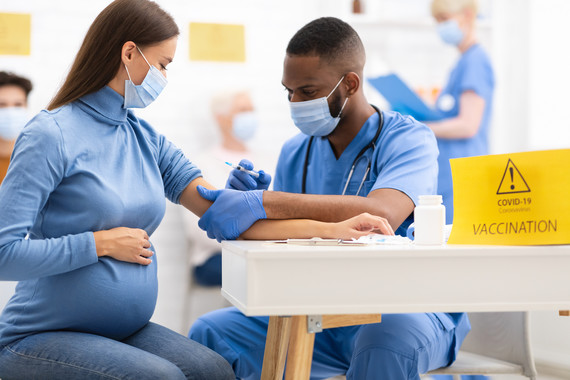 Their discussions revealed common thinking on the global direction needed for progress. The dialogue was continued and explored further with EO, EMA, and MHRA co-chairing another workshop in February 2021, under the auspices of the International Coalition of Medicines Regulatory Authorities (ICMRA).
The regulators collaboratively expressed their expanding vision in a February 2021 article published in the journal Clinical Pharmacology and Therapeutics. Europe Office Deputy Director Sandra Kweder, M.D., and International Policy Analyst LCMDR Shannon Thor, Pharm.D., were co-authors of the article, which calls for a paradigm shift to ensure access to safe medicines for pregnant and breastfeeding women. Their recommendations included:
- Approaching the use of medicines in pregnancy and breastfeeding from a benefit-risk perspective.
- Exploring innovative approaches to nonclinical reproductive toxicology.
- Systematic consideration of possible use of medicines by pregnant and breastfeeding women.
- Addressing regulatory and liability barriers to clinical trial inclusion.
- Supporting clinical decisions, rational use, and appropriate dosing through systematic and timely study of medicines likely to be used in this population.
- Optimizing the regulatory system to ensure timely and efficient use of all available data resources.
- Challenging industry and researchers to partner globally to develop robust electronic data collection and analysis.
Both Kweder and Thor elaborated on these ideas at the Drug Information Association virtual annual meeting in July 2021.
 Kweder and Thor further highlighted the FDA’s contributions in a recent FDA Voices article: “Global Regulators Envision Paradigm Shift Toward Inclusion of Pregnant and Breastfeeding Women in Clinical Research for Medicines and Vaccines.” Here, the article brings together these Europe Office authors plus contributors from the FDA’s Office of Women’s Heath (OWH), Center for Drug Evaluation and Research, and Center for Biologics Evaluation and Research.
As outlined in the Voices article, other activities are underway at FDA to change the paradigm, including:
- Guidance documents for clinical studies in relation to pregnant and breastfeeding women — addressing study design, ethical considerations, and inclusion challenges.
- Engagement with the Task Force on Research Specific to Pregnant and Lactating Women (known as PRGLAC, a multi-party effort established under the U. S. Department of Health and Human Services).
- OWH funding for a pregnancy treatment repository for health professionals to share real-world information about their experiences repurposing drugs for use beyond established labeling — more pointedly, labeling that often lacks any directions for use by pregnant or breastfeeding women.
Europe Office authors provided insight on the European program called Continuum of Evidence from Pregnancy Exposures, Reproductive Toxicology and Breastfeeding to Improve Outcomes Now (ConcePTION), which was established by the public-private partnership Innovative Medicines Initiative. Among other goals, they call for better-labeled safety information for improved decision-making, and improving and unifying existing approaches to traditional pregnancy registries.
All the Voices authors noted the challenge created during the SARS-CoV-2 pandemic for pregnant and breastfeeding women making treatment decisions regarding vaccination against COVID-19, with no hard information to guide them.
Developing a roadmap for change, through international cooperation and harmonization, will take much care, consideration, and communication between all stakeholders, Kweder and Thor have said. Despite persistent challenges, there is strong interest from the international regulatory community to continue the momentum in this important area of women’s health.
Papaya-Associated Salmonella Outbreaks in Mexico
In a study published last month, public health researchers from various international, federal, state, and local agencies[1] highlighted the importance of working collaboratively during a widespread outbreak of Salmonella infections associated with eating papayas from Mexico.
“A Series of Papaya-Associated Salmonella Illness Outbreak Investigations in 2017 and 2019 – A Focus on Traceback, Laboratory, and Collaborative Efforts,” recently published in Journal of Food Protection, looked at the four outbreaks of infections from multiple strains of Salmonella in 2017, and another outbreak in 2019, which altogether sickened 325 people in the United States. Among the 36 co-authors were Janete Oliveira and Ana Lilia Sandoval, Ph.D., of the Office of Global Policy and Strategy’s Latin America Office, as well as Kenneth Nieves, who was then of LAO.
Mexico produces 11% of the world’s papayas and is responsible for 80% of all fresh papaya available on the U.S. market. In the wake of a 2011 papaya outbreak and a high frequency (15.6%) of samples from Mexico that yielded Salmonella, the FDA issued Import Alert #21-17 in 2011. This required importers to provide the results of a third-party laboratory test for the presence of Salmonella — before the fruit could enter the United States.
[1] FDA’s Center for Food Safety and Applied Nutrition, The Centers for Disease Control and Prevention, FDA’s Office of Regulatory Affairs, FDA’s Office of the Commissioner, Maryland Department of Health’s Rapid Response Team, New Jersey Department of Health, New York City Department of Health and Mental Hygiene ‘s Bureau of Communicable Disease, and their Public Health Laboratory, Virginia Department of Health, Virginia Department of Agriculture and Consumer Services, California Department of Public Health
 Traceback, laboratory, and epidemiologic evidence collected during the 2017 and 2019 Salmonella outbreaks indicated papayas as the likely vehicle and identified the source of the papayas. To arrive at those conclusions, state and FDA laboratories recovered Salmonella from papaya samples from various points of distribution, including import entry, and conducted a series of tests to obtain the bacteria’s genetic profile.
Federal and state partners led traceback investigations to determine the source of papayas — four farms in Mexico for the 2017 outbreak and one farm in Mexico for the 2019 outbreak. However, traceback was challenging due to lack of verified purchase dates from some patients; inadequate recordkeeping to demonstrate specific brand and lot numbers; differences in how the same product was reflected on records; similar branding that made it difficult to differentiate between products; and the commingling of product. The FDA’s Coordinated Outbreak Response and Evaluation Network provided a hub for federal state and local partners to share data and evidence, the authors said.
Capitalizing on lessons learned
These findings led to recalls, import alerts, and public guidance. The outbreak also highlighted the value of international collaboration with Mexican regulatory partners. The U.S. and Mexico had established the Produce Safety Partnership (PSP) Statement of Intent in 2014 to strengthen cross-border relationships between the two countries in the area of disease surveillance, traceback and regulatory action.
Last year the PSP was replaced by a new Statement of Intent for a Food Safety Partnership (FSP) with Mexico’s National Service of Agro-Alimentary Health, Safety and Quality (SENASICA) and the Federal Commission for Protection against Sanitary Risk (COFEPRIS). The governance structure of the partnership called for the establishment of several working groups. In one group, the FDA, SENASICA, and papaya industry representatives have been actively engaged in developing and implementing training for growers and importers. Tools have also been developed to help growers perform self-assessments regarding how well they are utilizing what they have learned in the training. The FSP will be celebrating its first year anniversary later this month.
LAO has played a significant role in support of these cooperative efforts between the two governments and the papaya industry.
Resources
A Series of Papaya-Associated Salmonella Illness Outbreak Investigations in 2017 and 2019 – A Focus on Traceback, Laboratory, and Collaborative Efforts | Journal of Food Protection (allenpress.com)
FDA Redoubles Call to Action for Papaya Industry to Keep Consumers Safe from Foodborne Illness | FDA
FDA Investigates Multiple Salmonella Outbreak Strains Linked to Papayas | FDA
Latin America Office | FDA
MDSAP Topic of Productive Webinar Series
Promoting international harmonization is a priority for FDA. Over time FDA has supported regulatory convergence - when the regulatory requirements across countries or regions become more similar or “aligned” because of the gradual adoption of internationally recognized technical guidance documents; standards and scientific principles; and common or similar practices.
One important area of regulatory convergence is a move towards a global approach to auditing and monitoring the manufacturing of medical devices. A global effort called the Medical Device Single Audit Program, or MDSAP, was first envisioned by the International Medical Device Regulators Forum in 2012. The program has been fully operational since 2017, following successful completion of a pilot. MDSAP allows MDSAP-recognized Auditing Organizations to conduct a single regulatory audit of a medical device manufacturer that satisfies the relevant requirements of the regulatory authorities participating in the program.
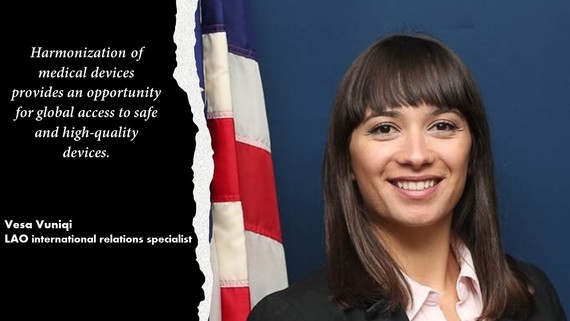 Today, there are five international partners and full members of the program: FDA; the Therapeutic Goods Administration of Australia; Health Canada; Japan’s Ministry of Health, Labour and Welfare, and the Japanese Pharmaceuticals and Medical Devices Agency; and Brazil’s Agência Nacional de Vigilância Sanitária, the only full member regulatory authority in Latin America. In addition, the European Union, United Kingdom’s Medicines and Healthcare products Regulatory Agency, and the World Health Organization are MDSAP Official Observers. Argentina's National Administration of Drugs, Foods and Medical Devices, Republic of Korea's Ministry of Food and Drug Safety, and Singapore's Health Sciences Authority are MDSAP Affiliate Members.
Each participating regulatory authority uses MDSAP audit reports in the way that makes the most sense based on their regulatory framework and the potential operational efficiencies to be gained. FDA, for example, accepts MDSAP audit reports as a substitute for routine agency inspections.
FDA is interested in encouraging further interest in MDSAP across Latin America so in June, the agency co-sponsored a series of webinars on the topic with the Inter-American Coalition for Regulatory Convergence. It was attended by more than 450 participants, in over ten countries in the Americas – plus regulators from Europe and Asia.
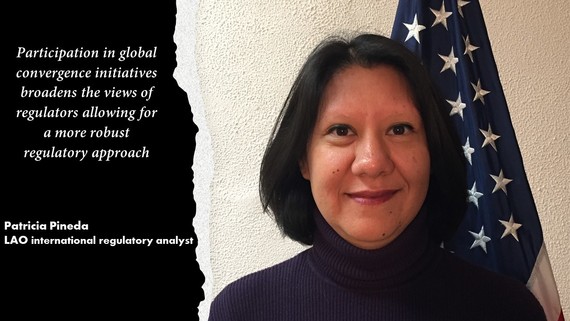 Patricia Pineda and Vesa Vuniqi from the FDA’s Office of Global Policy and Strategy’s Latin America Office collaborated with the Center for Devices and Radiological Health in hosting the virtual sessions which covered how the audits from MDSAP can be used as a tool for regulatory agencies to jointly leverage regulatory resources to manage an efficient, effective, and sustainable single audit program focused on the oversight of medical device manufacturers’ quality management systems.
“Participation in global convergence initiatives broadens the views of regulators allowing for a more robust regulatory approach,” said Pineda.
During the first webinar, discussions centered around the MDSAP audit model and how MDSAP audits are conducted; the processes and policies used by regulatory authorities to recognize and oversee auditing organizations; Good Manufacturing Practice regulations; and the FDA’s intention to harmonize and modernize the Quality System Regulation by transitioning to ISO 13485, the international standard for quality systems management that is best geared to medical devices.
The second webinar focused on an actual MDSAP audit from an auditing organization by examining a case study and explaining what occurs when conducting an inspection. “We discussed that one with the regulatory authorities to determine how they are regulating and managing all kinds of nonconformities so we can see if they are aligned or not with the ISO 13485 and the MDSAP,” said Pineda.
The third session was introduced by LAO Director Katie Serrano and was used to gain an understanding of how the regulatory authorities already participating in MDSAP are leveraging its benefits. Additionally, presenters shared how to become a participant of the program; how to engage; and how to leverage outcomes from the MDSAP.
The fourth webinar, held on June 24 for regulators only, was designed to address any outstanding questions and/or concerns, as well as facilitate open discussion regarding status or interest for adoption of MDSAP and ISO 13485.
MDSAP has not only created efficiencies for regulatory authorities but for industry as well. With the program, they have been able to demonstrate compliance with regulatory authorities across several major global markets while reducing their overall number of audits or inspections or the resources spent on them.

|
Ravi Bharwani has transitioned into the role of principal policy advisor in the OGPS immediate office (IO). In this position he will lead policy engagements and coordination, advise the associate commissioner on complex issues, and manage IO functions – including budget formulation and oversight, quality and knowledge management, and the OGPS executive secretariat.
Bharwani started his FDA career as a student intern in 2007 with the Office of Resource Management, part of the Office of Regulatory Affairs (ORA). Upon graduating from the American University with a degree in public policy he was selected as the first employee to join the new ORA Quality Management Staff.
|
|
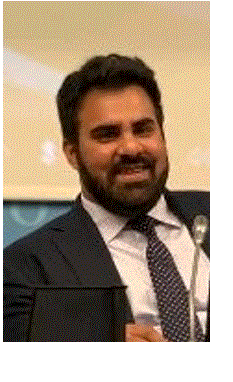 |
In this position he performed quantitative and qualitative analysis and helped stand up the new program while working toward his graduate degrees in business administration and finance from the University of Maryland, College Park.
In 2013, Bharwani joined the newly formed Office of Public Health and Trade in what was then the Office of International Programs (OIP) as an international trade policy analyst focusing on OIP’s World Trade Organization (WTO) portfolio and coordinating policy positions with the Technical Barriers to Trade and Good Regulatory Practices interagency groups within the WTO.
In 2017 he joined the Global Regulatory Operations and Policy Directorate (GO) as a policy advisor where he negotiated FDA equities in the United States-Mexico-Canada Agreement, managed the GO/IO budget, and coordinated policy issues with HHS and the trade-promoting agencies. Since the creation of OGPS he’s worked on managing the OGPS budget, preparing positions for Congressional and HHS stakeholders, and advancing policy coherence across OGPS.
In an email to staff, OGPS Associate Commissioner Mark Abdoo said Bharwani, a Washington, D.C. resident, is a “long-time and oft-disappointed supporter of the New York Jets and Knicks and Tottenham Hotspur.”
 |
|
Jeanne Etkins has joined the Communications Team in the Office of Global Diplomacy and Partnerships on a 120-day detail. She has worked for nine years in the Office of Food Safety and Applied Nutrition and serves on the HHS Healthy People 2030 Workgroup (Health Communication and Health Information Technology) and the HHS Health Literacy Workgroup.
Etkins has an M.A. degree in English language and literature from the University of Maryland in College Park, and her academic background includes graduate work in social work and in education.
|
Her experience includes writing and editing for print, broadcast, and social media. She has taught writing and rhetoric at the college level and within the FDA. Jeanne founded and directed the Capital Acoustic Neuroma Association, a nonprofit association supporting people undergoing brain surgery in the Washington-Maryland-Virginia area.
|
Nicole Shokatz departed the China Office (CNO) last month after spending six years inspecting food facilities throughout the country.
Now on detail, and living in Minneapolis, she works in the Office of Regulatory Affairs with the team serving as the office’s focal point for internal, international, and federal partners to ensure FDA regulated products are safe and to promote and protect public health worldwide. The detail includes foreign authority inspection notifications and activity reporting and collaboration activities relating to Systems Recognition and Mutual Recognition Agreements.
|
|
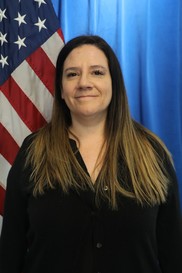 |
Shokatz began her 12-year FDA career as a food consumer safety officer (CSO) in Milwaukee. There, she inspected dairy, seafood, low-acid canned foods, acidified, and bakery manufacturing operations around Wisconsin.
Before joining FDA in 2009, Shokatz was a Milwaukee health inspector and a registered sanitarian, inspecting the city’s restaurants, schools, grocery stores, and other facilities that served and sold food products.
Of her time in China, Shokatz says: “I really enjoyed conducting inspections in China. It was an eye-opener [about] the cultural differences [between the United States and China] and the difficulties creating a safe global food chain.”

Doing the Needful During India's "Second Wave"
In 2021 a second wave of COVID-19 hit India fast and hard. As the country locked down, FDA’s India Office jumped into action, getting oxygen and medicine to critically ill patients and N95 masks to those desperately working to save them. Director of our India office for only a few months, Sarah McMullen details how she and her staff “did the needful,” often working long hours well beyond their normal jobs…From a Global Perspective.
LAO Meets with New Regulatory Commissioner of Mexico
Latin America Office Director Katie Serrano met in July with Alejandro Svarch, federal commissioner of Mexico’s health agency COFEPRIS, to discuss regulatory convergence and effective use of available resources and expertise (reliance) for food, drugs, and medical devices.
This was LAO’s first in-person meeting with Commissioner Svarch since his appointment in February 2021 and LAO’s first with a regulatory counterpart since the 2020 pandemic began.
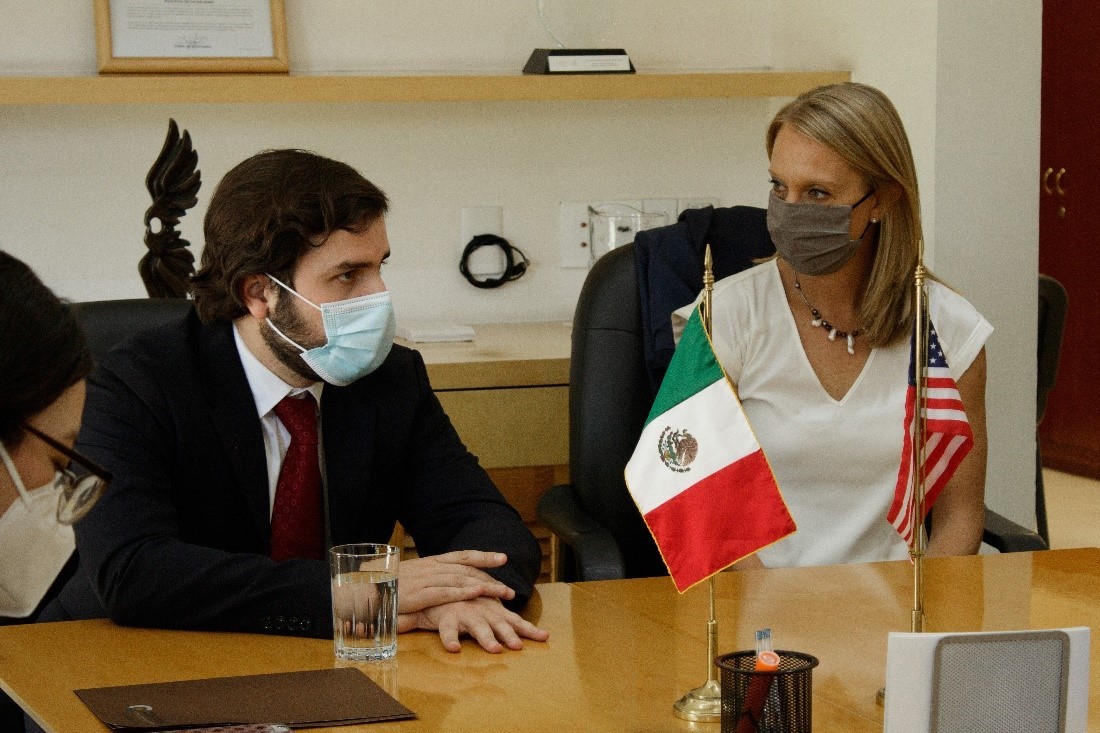 Federal Commissioner Alejandro Svarch with LAO Director Katie Serrano
During the meeting, Commissioner Svarch highlighted his commitment to COFEPRIS’s continued collaboration with FDA on a broad range of topics. The commissioner also presented new possibilities for collaborations between our regulatory agencies:
- Remote inspections
- Post-market surveillance of drugs and medical devices
- Regulatory challenges at the borders
- Whole genome sequencing for combating antimicrobial resistance
COFEPRIS, one of two food safety authorities in Mexico, regulates how food is processed, held, and manufactured. This agency also regulates drugs, biologics, vaccines, medical devices, cosmetics, pesticides, and toxic substances. SENASICA, Mexico’s other agency, aims to reduce the risk of contamination in fresh produce. FDA has a long history of working together with both agencies, leading to strides in critical areas such as inspections, outbreak response, and food safety.

The Dear International Colleague Letter (DICL) is an email sent to a listserv of about 20,000 subscribers – both D.C.-based embassies and international stakeholders. It is intended to inform them of any FDA announcements that are relevant to an audience with international interests. Here are the most recent DICLs:
Invitation to an FDA dialogue on Good Regulatory Practices
Manufacturing, Supply Chain, and Inspections during the COVID19 Public Health Emergency
FDA Authorizes Additional Vaccine Dose for Certain Immunocompromised Individuals
Upcoming events
August
August 25 – Manufacturing, Supply Chain, and Inspections during the COVID19 Public Health Emergency
September
September 1 – Parenteral Drug Industry Congress Annual Meeting
September 1 – MedTec China 17th Exhibition
September 17 – World Patient Safety Day
September 27 – 2021 PDA/FDA Joint Regulatory Conference
October
October 15 – Global Handwashing Day
October 16 – World Food Day
October 19-21 – New Era of Smarter Food Safety Summit
Don't Forget
OGPS maintains a Twitter account. Please follow us @FDA_Global.
Connect with Us
Read thought-provoking pieces covering international topics in From A Global Perspective.
Subscribe
Don't miss out on future Global Updates or other international news from OGPS. To sign up, click "Manage Subscriptions" below then follow the prompts and select the "International Programs" box.
|